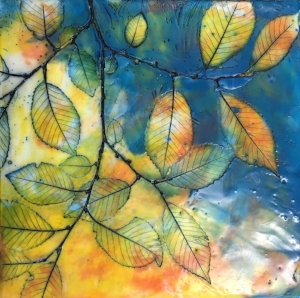Watercolor Feather Print
Eco Print using Chestnut, Oil and Onion Skins
Gelli Plate Nature Printing
Ginko Encuastic Nature Print
Eco Print on Paper
I used to love printmaking when I was in college in Colorado – the big presses exerting 1500 pounds per inch of pressure, the smell of the inks, and the ability to reproduce multiple copies of single hand-created image. I loved cutting the images up and recombining them. I carved wood blocks, I made etchings, I did monotypes - but the cost of the press and the highly technical nature of printmaking meant that I didn’t do it much in those first few years after college.
But the idea of reproducing an image stuck with me, as did creating an indirect image by inking a surface or capturing a texture. I played with photocopies, collage, and what I called “junk printing” – pulling a print from inked up bits of foam, string, or other found objects.
Something else stuck with me from college and my time in Colorado. I had a love of hiking and the natural world! I tried using photographs and found natural objects in my work, but it never quite clicked. The closest I came was color – even now, the colors in my work are strongly influenced by the turquoise skies, rusty red rock formations, citrus green lichens, and bold yellow-orange aspen leaves of Colorado and the Southwestern United States.
In 2010, I was invited to teach encaustic to members of the Nature Printing Society, then having their annual workshop on the Oregon Coast. Encaustic is my primary medium – a combination of molten beeswax, resin, and pigments that is used as a painting and collage medium. I experimented a bit with pressing leaves into the surface of the warm wax to get an impression – a technique I adapted from existing methods of creating texture in the encaustic surface.
For the past seven years, I’ve gone back to that annual workshop – sometimes to teach, but always to learn. My work now includes a variety of different nature printing techniques. Nature printing as we know it first emerged in the middle ages as a way of recording and identifying medicinal plants. The plants were inked or painted and then pressed onto paper, leaving behind an image. This perfectly proportioned imprint could then be colored or annotated to provide additional information.
Now, I’m not only pressing the plants into encaustic, but also using their natural tannins to create designs on paper and silk ( called Eco Printing) and printing them with watercolors and inks on a variety of papers. I’ve even experimented with printing on raku-fired pottery and precious metal clay!
Much of my work has to do with belonging, memory, and a sense of home. Whether the nature prints I do stand alone, or are incorporated into a larger, more complex painting, these natural elements ground the work. The plant impressions are a kind of memory and their inclusion adds a sense of place. And Western North Carolina offers a wealth of materials!
Bridget Benton teaches Encaustic and Nature Printing, Eco Printing on Silk and Art Paper, Resin Casting of Natural objects and much more at 310 ART







